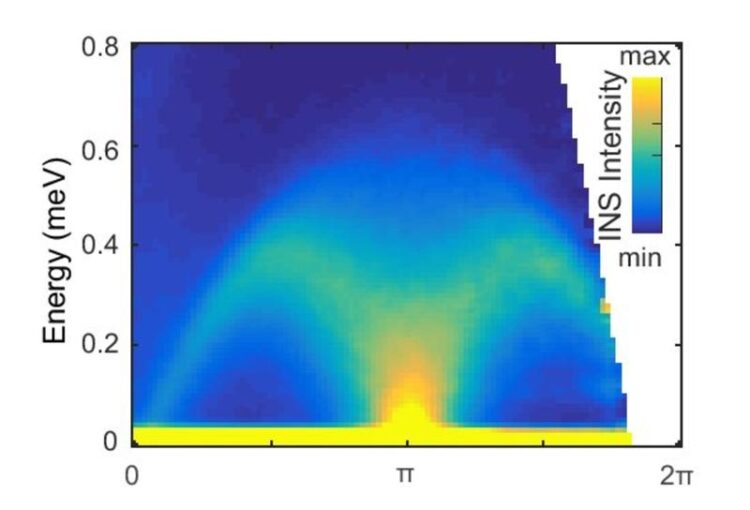Unconventional order in a low-dimensional magnet

Inelastic neutron scattering spectrum of YbAlO₃
(c) MPI CPfS
The analogy between the behaviour of different quantum particles which have the same quantum nature is one of the most fascinating aspects of science. A simple but prominent example is the analogy between the behaviour of electrons (fermions) in a one-dimensional metal and spinons (fermions) in a one-dimensional quantum magnet.
But, what are spinons?

(c) MPI CPfS
It is generally known that magnetic fluctuations in conventional magnets can be seen as a wave of deflection of the magnetic moments out of the equilibrium. These waves are described by quantum mechanics as quasi-particles, known as magnons, which carry integer spin momentum S = 1 and therefore are bosons. However, in one-dimensional systems magnons decay (fractionalize) into two S = 1/2 spinon quasiparticles which are fermions. Their low-energy physics is described by the Tomonaga-Luttinger liquid of spinless fermions, similar to the conduction electrons in one-dimensional metals. Such Tomonaga-Luttinger liquid behavior has been observed in the quantum magnet YbAlO₃ (see press release: Realization of a Tomonaga-Luttinger liquid in YbAlO₃).
Recently, an international team of scientists from Germany (MPI CPfS Dresden), USA, China, Russia and Ukraine has studied YbAlO₃ by means of magnetization and neutron diffraction experiments supported by numerical calculations and has shown that the weak interchain coupling produces Umklapp scattering between the left- and right-moving spinons.
Under finite magnetic fields Hz this stabilizes an “unconventional” incommensurate spin-density wave order at the q = 2kF with kF being the Fermi wavevector. This mechanism is similar to Fermi surface nesting observed in metals. The Umklapp processes open a route to multiple coherent scattering of fermions, which results in the formation of satellites at integer multiples of the incommensurate fundamental wavevector Q = nq which were indeed measured by elastic neutron scattering.
These results provide surprising and profound insight into band-structure control for emergent fermions in quantum materials and uncover a process of multiple fermion scattering in one-dimensional systems.
Wissenschaftliche Ansprechpartner:
Manuel.Brando@cpfs.mpg.de
Originalpublikation:
DOI:10.1038/S41467-021-23585-Z
Weitere Informationen:
https://www.cpfs.mpg.de/3344231/20210812?c=2327
https://www.cpfs.mpg.de/2979382/20190218?c=2123253
Media Contact
All latest news from the category: Physics and Astronomy
This area deals with the fundamental laws and building blocks of nature and how they interact, the properties and the behavior of matter, and research into space and time and their structures.
innovations-report provides in-depth reports and articles on subjects such as astrophysics, laser technologies, nuclear, quantum, particle and solid-state physics, nanotechnologies, planetary research and findings (Mars, Venus) and developments related to the Hubble Telescope.
Newest articles

Largest magnetic anisotropy of a molecule measured at BESSY II
At the Berlin synchrotron radiation source BESSY II, the largest magnetic anisotropy of a single molecule ever measured experimentally has been determined. The larger this anisotropy is, the better a…

Breaking boundaries: Researchers isolate quantum coherence in classical light systems
LSU quantum researchers uncover hidden quantum behaviors within classical light, which could make quantum technologies robust. Understanding the boundary between classical and quantum physics has long been a central question…

MRI-first strategy for prostate cancer detection proves to be safe
Active monitoring is a sufficiently safe option when prostate MRI findings are negative. There are several strategies for the early detection of prostate cancer. The first step is often a…



